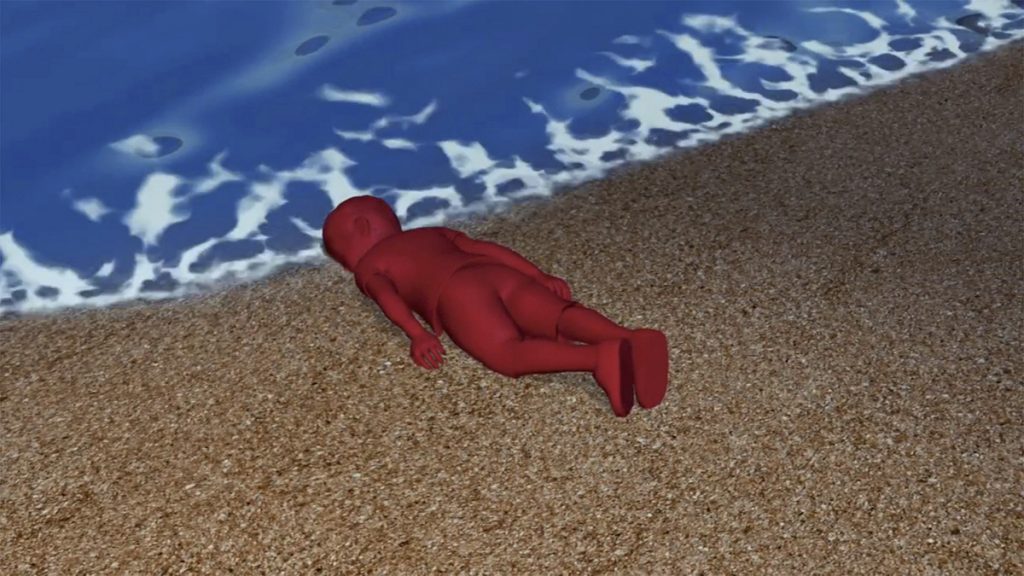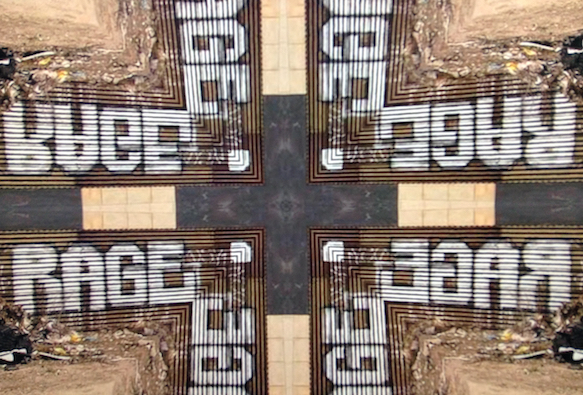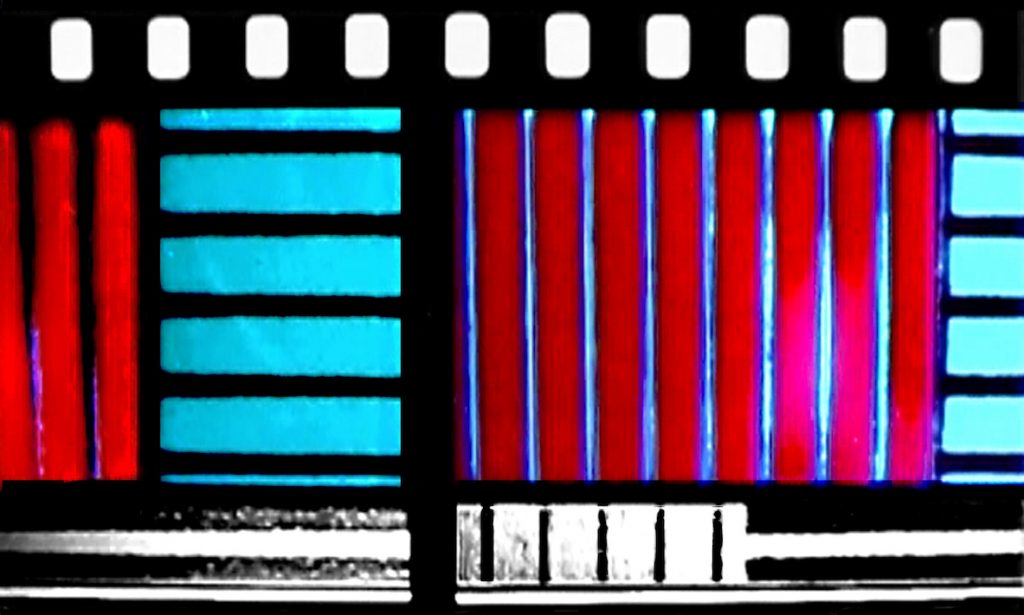While the theme ‘violence in animation’ might mostly be associated with indestructible cartoon characters, here I reflect upon the capacity of non-figurative animation to directly assail the senses. Can abstraction be as effective as figurative art in communicating issues of violence? Few female artists work in abstract animation[i]. Could this perhaps be because it is considered to limit expression of the personal and political, which may be important to female makers? Focusing on the work of two female artists, Peggy Ahwesh and Lis Rhodes, whose practices pose a consistent critique of forms of violence and its representation in the moving image, I propose that abstract animation is a highly effective method through which to explore issues of violence.
PEGGY AHWESH. She Puppet (2001) marked US avant-garde filmmaker Ahwesh’s move from thirty years of live-action towards 3D CG animation. Appropriating aspects of the game Lara Croft: Tomb Raider, the violence to women characteristic of games is critiqued here through a hyperbolic CG treatment of death.
Following this, Ahwesh plundered 3DCG online media news channels, enlarging the plight of the female individual to include vulnerable humans generally. Lessons of War (2015), for example, depicts issues of violence at a remove: monochrome dolls washed up on the beach point to the consequences of the refugee crisis, yet express no reaction to their plight (see Figure 1). This stylization and visual simplification of the media’s treatment of tragedy is considered to be violent because it is abstracted to the extent that individual suffering is diminished. [ii]
Moving further into abstraction, Border Control (2019) employs imagery where the referent is only remotely discernible. This installation comprises four flat screens positioned on the floor, holding video prototypes of Trump’s wall, conceived to separate Mexico and the US. The imagery of this military zone is heavily processed and appears simulated. Industrial materials, piles of trash, and graffiti: ‘rage’, point to an uncared for and tense environment (see Figure 2). The monotony of uniform and straight roads carrying trucks moving at one pace further underscores the threat that any irregularity will be monitored.
Improbably, then the whole scene is swooped up through CG manipulation that causes figure and ground to collapse, to merge and multiply in kaleidoscopic patterns. The emotive inscription, ‘rage’, on its concrete segment, is quadrupled and rotated. It is as though the ferocity of outrage at Trump’s violent construction negates it, and CG animation affords the artist to enact such a fantasy.
The artist’s intention is that the effect is psychedelic [iii] as though abstraction is the only recourse when reality itself is so senseless. The swirling colors might be experienced as peaceful and meditative. Alternately, the collapse of formerly solid objects may provoke a sense of loss of control and of being hypnotically disoriented. Arguably then, formal aspects, such as rotating movement, loss of perspective, and multiplication of the same forms, hold power to provoke an experience of violence.
LIS RHODES. UK experimental filmmaker Lis Rhodes began her career with wholly abstract animated works, Dresden Dynamo (1974) and two-projector installation Light Music (1975). Simple graphic preprinted ‘letratone’ sheets, composed of circular dots and lines of varying density, were transferred directly onto the film-strip. Though the transfer material is flimsy, the uniform shapes give a consistency of image that is robust and machine-like. The unvarying repetition of these forms reflects the programmatic [iv] mode of abstract animation. The letratone crosses both the picture and soundtrack area, such that we are able to hear what’s seen, whilst listening to the imagery. The number of artists to exploit this method amount to a minor genre referred to as ‘optical sound films’.
Because of this dynamic of seeing sound, the sense of assault in Dresden Dynamo is doubled, as both vision and hearing are exposed to repetitive forms. At a visual level, the shapes produce a strobe effect, while the same forms in the sound zone translate to a machine gun-like noise, or an impression that the apparatus is malfunctioning (see Figure 3). In Light Music the sensation of being trapped and bombarded is even trebled because the projected light beams clash and collide across the auditorium: the viewer may choose to enter this space and be ‘kettled’ between the sculptural light rays.
The principles of being battered and entrapped by abstract animated forms, explored by Rhodes so effectively at a perceptual level, carry through to her later live-action films, such as In the Kettle (2010-12) in which she combines abstraction and representation as a means to critique the use of surveillance and state violence against political demonstrators.
CONCLUSION. The optical sound film is commonly described in terms of its aggressive qualities, found to be cacophonous and striking, [v] and creating an overwhelming visual assault. [vi] It is clear then that abstract animation has the power to impress upon the senses in ways that provoke discomfort. Ahwesh and Rhodes have employed varying degrees of abstraction in their animated films and through this have extended the filmic language through which they articulate issues relating to violence.
Vicky Smith’s work in experimental animation explores notions of shared vulnerability. Her work screens internationally, in galleries and festivals. She runs workshops in experimental film practice and has curated film screenings, including Go, Go, Go! Women in Experimental Animation (2019). Her publications include: Experimental & Expanded Animation: Current Perspectives and Practices, co-edited with Nicky Hamlyn (2018) and ‘Not (A) Part: Handmade animation, materialism and eco-aesthetic cinema’ in Animation Practice, Production & Process issue 7 (2019). She lectures at The University for Creative Arts, Farnham.
[i] See: http://greatwomenanimators.com/category/abstract-animation/ (Accessed 28/09/2021). Only ten practitioners are entered under the section ‘abstract animation’. Peggy Ahwesh is the most recent.
[ii] Mutambu, Tendai (2021), ‘Animating Catastrophe’ in Peggy Ahwesh: Vision Machines, Bristol Mousse Publishing/ Spike Island, pp. 76-85. The catalog was published by Spike Island to accompany Ahwesh’s exhibition of the same name.
[iii] See microscope gallery press release here: https://www.artsy.net/artwork/peggy-ahwesh-border-control (Accessed 28/09/2021).
[iv] Malcolm Le Grice identifies two tendencies in abstract film: the first, governed by order, programme, and mathematical principles can be observed in the work of Rhodes. The second, more arbitrary, illusionist, and associative, is evident in Ahwesh’s practice. See Le Grice, Malcolm (1977), Abstract Film and Beyond. Cambridge/ London: MIT Press.
[v] Webber, Mark (2001), “Seeing Sound: Lightning Strikes the Optic Nerve”, https://markwebber.org.uk/archive/2001/10/17/seeing-sound/ (Accessed 25/09/2021).
[vi] Curtis, David (2007), A History of Artists Film and Video in Britain, London: BFI Publishing, p. 234.



